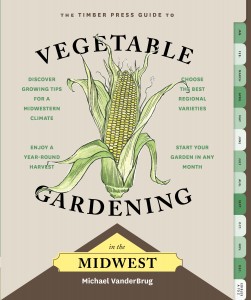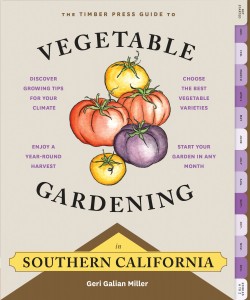From the Library: The Timber Press Guide to Vegetable Gardening
Posted in From the Library on February 11 2016, by Esther Jackson
Esther Jackson is the Public Services Librarian at NYBG’s LuEsther T. Mertz Library where she manages Reference and Circulation services and oversees the Plant Information Office. She spends much of her time assisting researchers, providing instruction related to library resources, and collaborating with NYBG staff on various projects related to Garden initiatives and events.
 Let’s say you’re new to vegetable gardening. Or, let’s say that you’re not new to vegetable gardening, but you have just relocated to a new region of the United States, and you want to start planning your garden. Where on earth should you begin looking for information?
Let’s say you’re new to vegetable gardening. Or, let’s say that you’re not new to vegetable gardening, but you have just relocated to a new region of the United States, and you want to start planning your garden. Where on earth should you begin looking for information?
Although it may seem obvious, it is sometimes overlooked that plants will have different care requirements depending on where they are grown. Methods used to grow tomatoes, for example, will be different depending on whether or not the same species or variety is grown in the Northeast or the Southwest. Often, specific varieties are suggested for specific regions, as a tomato that thrives in one area might languish in another. Like a good recipe, the art of growing a particular vegetable must be modified and refined by each individual gardener, as there can be differences in what a plant needs from region to region, state to state, and even yard to yard. There is no “one size fits all” when it comes to vegetable gardening, but a recent series from Timber Press is a great start.
Timber Press has heard the cry of the regional gardener and since 2013 has been releasing editions of the Guide to Vegetable Gardening series focused on the different regions and climates of the United States—giving just the right amount of information to get a garden started. These books are geared toward the novice gardener, or for those flirting with the idea of vegetable gardening. Regions covered thus far, (in order of publication), are the Pacific Northwest, the Southeast, the Mountain States, the Northeast, the Southwest, the Midwest, and Southern California. For this blog entry, I reviewed the two most recent guides: the Midwest and Southern California.
The series as a whole is wonderful. It’s unlikely that a gardener would need to own all six books in this series, although experienced horticulturists may find having information about the variation in plant requirements to be helpful. Each separate book treats the reader to an introduction to the region, “Gardening 101,” and a garden planning section. Readers are then taken month by month through garden-related tasks, and the style across the series is accessible and easy to follow. Following the monthly activities section, each book has an A–Z edibles list—a specially-curated list of vegetables that each author knows to be successful and tasty.
The consistency of the series is a great strength. That said, each guide has a unique tone and flavor, courtesy of its author. Midwest, (which includes Illinois, Indiana, Iowa, Kansas, Michigan, Minnesota, Missouri, Nebraska, North Dakota, Ohio, South Dakota, and Wisconsin), was written by Michael VanderBrug, a Michigan-based author and vegetable farmer, who is also the owner of a farm-to-table restaurant in Grand Rapids. VanderBrug welcomes his reader in joining the great agricultural history of the Midwest, and emphasizes the importance of knowing one’s garden and its various microclimates. Even those not planning a garden in the Midwest will find that following his calendar and narrative is surprisingly soothing, as he navigates the seasons and their chores.
 Southern California was written by Geri Galian Miller, the founder of Home Grown Edible Landscapes, who regularly contributes to the Huffington Post and maintains the blog GroEdible, among other things. Miller’s enthusiasm for her region jumps off the page from the start. SoCal has it all—the good and the bad—but the good is good, Miller emphasizes. Still, SoCal has a wide range of challenges, as Miller is quick to caution readers. Southern California doesn’t give much in the way of tips for gardening in drought, but, in all fairness, that isn’t the goal of the book. Miller, like the other authors in this series, is most excited about telling readers what they can accomplish in their region.
Southern California was written by Geri Galian Miller, the founder of Home Grown Edible Landscapes, who regularly contributes to the Huffington Post and maintains the blog GroEdible, among other things. Miller’s enthusiasm for her region jumps off the page from the start. SoCal has it all—the good and the bad—but the good is good, Miller emphasizes. Still, SoCal has a wide range of challenges, as Miller is quick to caution readers. Southern California doesn’t give much in the way of tips for gardening in drought, but, in all fairness, that isn’t the goal of the book. Miller, like the other authors in this series, is most excited about telling readers what they can accomplish in their region.
At first glance, the Timber Press Guide to Vegetable Gardening series is unassuming. However, these books are extremely well-crafted and are a fantastic resource for new gardeners as well as those new to a region. More complicated projects may require the home gardener to do more detailed research and further reading, but Miller does not overstate things when she writes, “We’re all learning together. And whatever your reason for getting your hands ‘dirty,’ this book will become your indispensable, dirt-stained, dog-eared guide and inspiration to get growing all year long!”
The Timber Press Guide to Vegetable Gardening in Southern California by Geri Galian Miller. Timber Press, 2016. 232 pages, 51 b/w illustrations. Softcover. $19.95. ISBN: 9781604695618
The Timber Press Guide to Vegetable Gardening in the Midwest by Michael VanderBrug. Timber Press, 2015. 184 pages, 53 b/w illustrations. Softcover. $19.95. ISBN: 9781604695526

